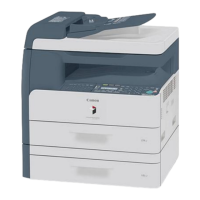1
2
3
4
5
7
8
9
6
TOP
Back Previous Next
3-19
Table of Contents
Index
Advanced Send
Features
Advanced Copy
Features
Network
Remote UI
System Monitor
System Manager
Settings
Reports and Lists
Troubleshooting
Appendix
6. Press [ ] or [ ] to select <ON> or
<OFF>, then press [OK].
<OFF>: Does not receive e-mail/I-faxes using the machine’s own
SMTP receiving function. If you want to receive e-mail/I-faxes
using a POP server, select <OFF>.
<ON>: Receives e-mail/l-faxes using the machine’s own SMTP
receiving function.
NOTE
The machine can receive I-fax images and communication error
notices only.
7. Confirm that <SMTP SERVER> is displayed,
then press [OK].
8. Use the numeric keys to enter the SMTP
server name, then press [OK].
– Enter the SMTP server name if the SMTP server name is
already registered in the DNS server.
– Enter the IP address of the SMTP server if the SMTP server
name is not registered in the DNS server.
9. Confirm that <POP> is displayed, then press
[OK].
10.Press [ ] or [ ] to select <ON> or
<OFF>, then press [OK].
<OFF>: Does not receive e-mail/I-faxes using a POP server. If
you want to receive e-mail/I-faxes using the machine’s own
SMTP receiving function, select <OFF>.
<ON>: Receives e-mail/l-faxes using a POP server.
NOTE
The machine can receive I-fax images and communication error
notices only.
11.Confirm that <POP BEFORE SEND> is
displayed, then press [OK].
12.Press [ ] or [ ] to select <ON> or
<OFF>, then press [OK].
<OFF>: Does not use an SMTP server that requires POP before
SMTP.
<ON>: Uses an SMTP server that requires POP before SMTP
(method for authenticating users who have logged in the POP
server before sending e-mail).
SMTP SERVER :a
smtp.company.com
Ex.

